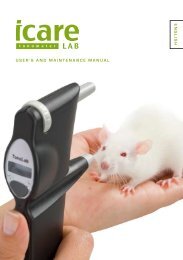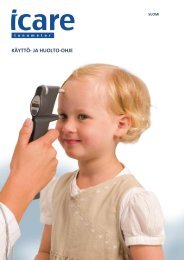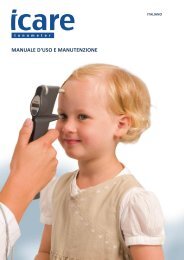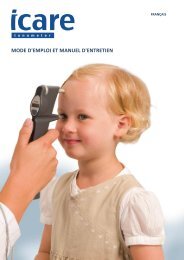USER'S AND MAINTENANCE MANUAL - Icare Finland
USER'S AND MAINTENANCE MANUAL - Icare Finland
USER'S AND MAINTENANCE MANUAL - Icare Finland
Create successful ePaper yourself
Turn your PDF publications into a flip-book with our unique Google optimized e-Paper software.
<strong>Icare</strong> tonometer TA01i manual<br />
English<br />
TURNING THE TONOMETER ON <strong>AND</strong> LOADING THE PROBE<br />
Place the wrist strap into the wrist strap attachment. Place the wrist strap around your wrist and secure it. The<br />
wrist strap protects the tonometer from dropping onto the floor accidentally. Insert batteries into the tonometer<br />
(page 9).<br />
Press the measurement button to turn the tonometer ON. The tonometer display will display all of the LCD<br />
segments (see the figure beside). Check that all of the segments are functional in the four-digit, sevensegment<br />
LCD display.<br />
Following a brief pause, the display will show “LoAd,” reminding the user to load the single use probe into the tonometer prior to measurement.<br />
Load the probe in the following way:<br />
Open the probe tube by removing<br />
the cap and insert the probe into<br />
probe base as shown in the<br />
image. After the probe has been<br />
inserted, be careful not to point it<br />
down before activating the<br />
tonometer in order to prevent<br />
the probe from falling out.<br />
Activate by pressing the<br />
easurement button once and the<br />
tonometer will be ready for<br />
measurement when 00 appears<br />
on the display. After activating<br />
the probe is magnetized and will<br />
not fall out.<br />
To obtain firm<br />
support for the<br />
patient’s<br />
forehead, in order<br />
to obtain an<br />
accurate<br />
measurement at<br />
the right distance,<br />
you can adjust the<br />
forehead support<br />
by turning the<br />
forehead support<br />
adjusting wheel.<br />
MEASUREMENT<br />
*Since local anesthetic may lower the tonometer reading, we recommend<br />
that you refrain from using an anesthetic when performing measurements.<br />
Ask the patient to relax and look straight ahead at a specific point. Bring the<br />
tonometer near the patient’s eye. The central groove should be in a horizontal<br />
position, and the distance from the eye to the front part of the collar should<br />
be the length of the collar. In other words, the distance from the tip of the<br />
probe to the patient’s cornea (see picture) should be 4-8 mm (1/6-1/3 inch).<br />
If necessary, adjust the distance by turning the forehead support adjusting wheel. Press the measurement button lightly to perform the measurement,<br />
taking care not to shake the tonometer. The tip of the probe should make contact with the central cornea. Six measurements are made consecutively.<br />
After each successful measurement, you will hear a short beep. Once the six measurements have been performed, the IOP will be shown on the display<br />
after the ‘P’.<br />
If there is an erroneous measurement, the tonometer will beep twice and display an error message. Press the measurement button to clear the error<br />
message. If several erroneous measurements appear, see error messages (page 10).<br />
To obtain the most accurate reading, six measurements are required, but the result is also displayed after the first measurement, which can usually be<br />
considered valid. The measurement values displayed are average values for all previous measurements (1.-5.). Single measurement values are not shown.<br />
Should there be variation between the measurements, ‘P’ will flash on the display after the sixth measurement.<br />
Following the performance of the entire measurement, a new measurement series can be begun by pressing the measurement button. The tonometer<br />
will then be ready for the next measurement series (00 will show on the display, see page 8).<br />
If the user doubts the validity of the measurement (for example, if the probe made contact with the eyelid, or missed the central cornea etc.), we<br />
recommend that he/she make a new measurement. In addition, when encountering unusual values (for example over 22mmHg or below 8 mmHg)<br />
we recommend the performance of a new measurement to verify the result.<br />
*Badouin C, Gastaud P. Influence of topical anesthesia on tonometeric values of intraocular pressure. Ophthalmologica 1994;208:309-313<br />
www.icaretonometer.com<br />
4

















